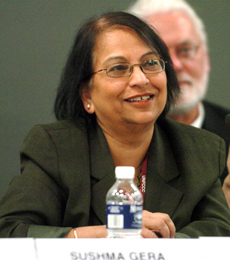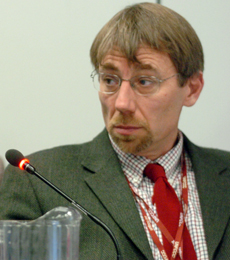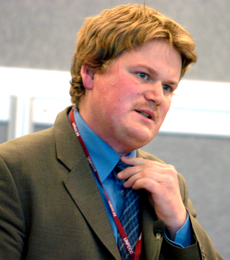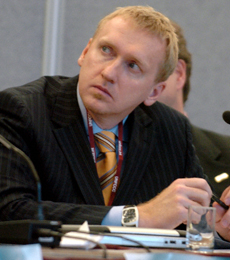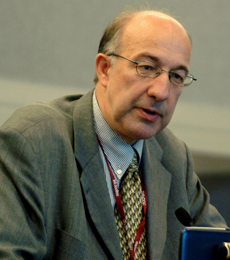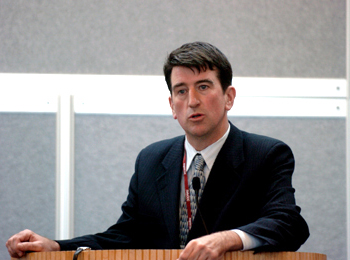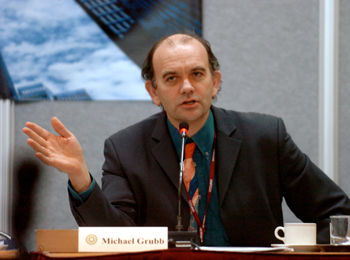 |
||
|
published by IISD, the International Institute for Sustainable Development
in cooperation with the UNFCCC Secretariat. |
|||
|
Special Report on Selected Side Events at COP 11 & Kyoto Protocol COP/MOP 1
|
|||||
| 28 November - 9 December 2005 | Montréal, Canada | |||||
|
CDM Executive Board: Question and Answer Session Presented by the UN Framework Convention on Climate Change |
|||
|
Responding to several participants’ concerns regarding non-inclusion of non-renewable biomass projects within small scale Afforestation and Reforestation CDM activities, Sushma Gera, Clean Development Mechanism Executive Board (CDM EB), noted that such projects lead to conservation of carbon pools in forests.
On a question regarding the share of proceeds covering administrative expenses of CDM to be USD 0.20 per Certified Emission Reduction (CER), Gera said the Board examined a number of scenarios, and chose this number to provide guidance. On the issue of consideration of new additionality tools, Jean-Jacques Becker, CDM EB, noted that concrete alternatives for additionality tools are still lacking. Regarding a question on consideration of sectoral CDM projects, Gera noted that the EB is seeking guidance from the COP/MOP 1. Responding to a question on improving CDM, Gera noted that the EB does have a management plan in this regard, however, some of the problem areas are not addressed by its current mandate. Gera noted that the Board’s “learning by doing” approach leads to the revision of approval procedures that often generates unpredictability. In response to a question regarding regional equity in distribution of CDM projects, Richard Muyungi, CDM EB, said the Board will organize forums for CDM Designated National Authorities twice a year, in addition to other capacity building activities. Responding to a concern regarding the progress of methodologies in the transport sector, Becker noted that currently there is only one methodology. On the new methodology for carbon capture and storage projects’ progress, Gera noted that the Board has yet to analyze these projects. Regarding registry, Rajesh Kumar Sethi, CDM EB, stated that the registry issues CERs upon verification of the Designated Operational Entity and that these CERs are further transferred to the project participants that are registered at that point. Kai-Uwe Barani Schmidt, UNFCCC Secretariat, presented on the CDM Yearbook 2005 outlining various CDM related activities that took place in 2005, including: the approval of the first CDM-MAP; the first 500 activities in the CDM pipeline; and the first 500 million CERs to be delivered through CDM guidelines. |
|||
|
|||
|
|||||||||||||||||||
|
|||
|
|||||||||||||||||||||||||||||
|
|||
|
Transitioning to a Low Carbon Economy Presented by Canada’s National Round Table on the Environment and the Economy |
||||
|
Glen Murray, Canada’s National Round Table on the Environment and the Economy, stressed the need for long term strategies.
Michael Grubb, UK Carbon Trust, reviewed the UK’s long term effort to reduce emissions by 60%. He highlighted success since 1990 in reducing emissions, increasing carbon intensity, removing the protection of old energy, diversifying energy supply, instituting a climate change levy and introducing some new technologies. He noted that targets require systems such as cap-and-trade to make carbon-saving technology bankable. He stated that national policies are needed for start-ups, field-trial technologies and to build at the industrial scale. Noting the primary role of private sector multinational investment, he said innovation and diffusion require deepening low carbon polices in industrialized countries, spreading policy best practice, and streamlining diffusion mechanisms like the CDM. Daniel Gagnier, ALCAN, reviewed his company’s efforts to reduce emissions and increase productivity between 2001 and 2004 including steps to: develop a better mix of energy sources; invest in low carbon technologies; and manage emissions generated through the entire product life cycle. He highlighted the importance of good science, rational economics, and improving the CDM. |
||||
|
|||
|
Enabling CDM in Asia and Pacific: Promotion of Renewable Energy, Energy Efficiency and Climate Change Abatement Presented by the Asian Development Bank |
|||||
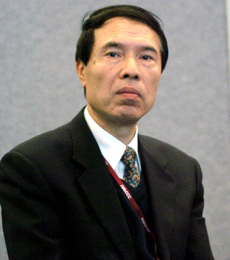 |
Toru Kubol, Asian Development Bank (ADB), presented an overview of ADB’s programmes to promote renewable energy, energy efficiency and climate change (REACH), which include provision of loans for CDM projects, projects relating to potential renewable energy and greenhouse gas abatement projects (PREGA), and a CDM facility.
Xuedu Lu, CDM EB, highlighted ADB’s role in capacity building for CDM projects in China. Rajesh Kumar Sethi, CDM EB, emphasized some of the CDM related activities in India and the role played by designated national authority in facilitating CDM. Wei Zhihong, Tsingshua University, highlighted some of the PREGA activities in China, and noted the need to expedite CDM activities. Chayun Budiono, PT Chazaro Gerbang International, outlined projects relating to utilization of biomass wastes in the wood based industry. Jivan Acharya, Winrock International, noted a number of projects under PREGA, such as biogas, trolleybus, and a Solar Tuki that replaces a Bull’s trench kiln with a vertical shaft kiln. |
||||
| Wei Zhihong, Tsingshua University noted the need to diversify the coal energy mix and promoting clean coal technologies | |||||
| Discussion: Participants discussed the lack of ADB’s focus on the Pacific, where CDM holds great potential, and the difficulty in monitoring many of the Nepalese projects. | |||||
|
|||
|
Climate Change Performance Index: country performance in mitigation of GHG emissions Presented by Germanwatch |
|||||
 |
Christoph Bals, Germanwatch, introduced the Climate Change Performance Index, which focuses on 53 countries whose emissions are most relevant to climate and will be published every two years. Bals explained that the index is intended to send a clear message to the public about the performance of these countries.
Manfred Treber, Germanwatch, highlighted the Index’s two quantitative components: domestic aggregate values and sectors where carbon dioxide emissions arise from, inter alia, energy transformation, transport, buildings and manufacturing. He explained that its qualitative component comprises expert knowledge on domestic politics and behavior in international diplomacy. Jan Burck, Germanwatch, provided an overview on how the Index was created stressing that it: includes only energy-related carbon dioxide emissions, not LULUCF; weighs quantitative measures as 80% and qualitative as 20%; and that the energy sector received double the weight in sectoral performance. Treber then presented the Index’s final rankings. Discussions included: whether countries’ performance will remain fixed on the scale; countries’ response to the Index; accounting for import and export emissions; and exclusion of the land use sector. |
||||
| Jan Burk, Germanwatch, said that the Aggregate main indicators for 2001-2003 were: CO2 emissions per capita; CO2 emissions per GDP; total primary energy supply (TPES) per GDP; and CO2 emissions per TPES | |||||
|
|||
|
Regional handbook on Procedures for JI-projects in the Baltic Sea Region Presented by the Nordic Council of Ministers |
|||
|
Olle Björk, Swedish Ministry for Sustainable Development, introduced the Testing Ground Facility (TGF) of the Baltic Sea Region Energy Cooperation, and listed its objectives, inter alia: building capacity to use Kyoto Protocol mechanisms; promoting the realization of high quality projects in the energy sector; gaining experience within the JI mechanism; and collaborating in addressing administrative and financial barriers.
Ash Sharma, Nordic Environment Finance Corporation, described the purpose, key features and portfolio criteria of the TGF. He gave examples of projects being negotiated and explained that TGF’s success will depend on: focusing on closing project negotiations; cultivating a project pipeline; raising capital; and cooperating and communicating with stakeholders in the region. Torleif Haugland, ECON, presented the TGF Handbook, which examines baseline and baseline methodologies, and detailed the JI requirements and project cycle. Among issues for consideration, he mentioned JI transaction costs, and project, market and policy risks. |
|||
|
|||
|
A workshop for negotiators: remote sensing science for monitoring of tropical deforestation Presented by Bolivia |
|||||
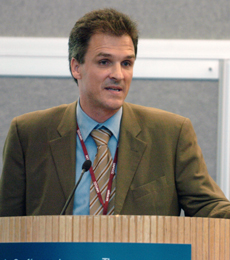 |
Joerg Seifert Granzím, Friends of Nature, presented on the Noel Kempff Climate Action Project, which certified carbon offsets obtained from the protection of natural forests and stressed the challenges in calculating additionality and leakage.
Eveline Trines, General Surveillance Society (SGS), gave an overview of certifying the avoidance of deforestation claimed by this project, and underscored the difficulty of evaluating the parameters associated with assessing carbon storage. Policy panel: Gisela Uloa Varga, Bolivia, said political, rather than technical, barriers exist in obtaining credit for carbon offsets from the avoidance of deforestation. Adrian Fernandez, Mexico, noted that the Project demonstrates that multiple local benefits can be delivered while pursuing global objectives. Darren Goetze, Canada, called for increasing funding in forest conservation and giving locals a stake in CDM forest projects. Wari Lea Iamo, Papua New Guinea, highlighted the objectives of the newly formed Coalition for Rainforest Nations, including decreasing emissions linked to deforestation. |
||||
| Joerg Seifert Granzím, Friends of Nature Bolivia, presented on the Noel Kempff Climate Action Project, which obtained certification for carbon offsets obtained from the protection of natural forests. He outlined challenges associated with this project, including calculating additionality and leakage | |||||
|
|
|||
|
||
|
Click the above button to go back to our ENB main coverage
|
||
|
|
|
|
|
||
|



